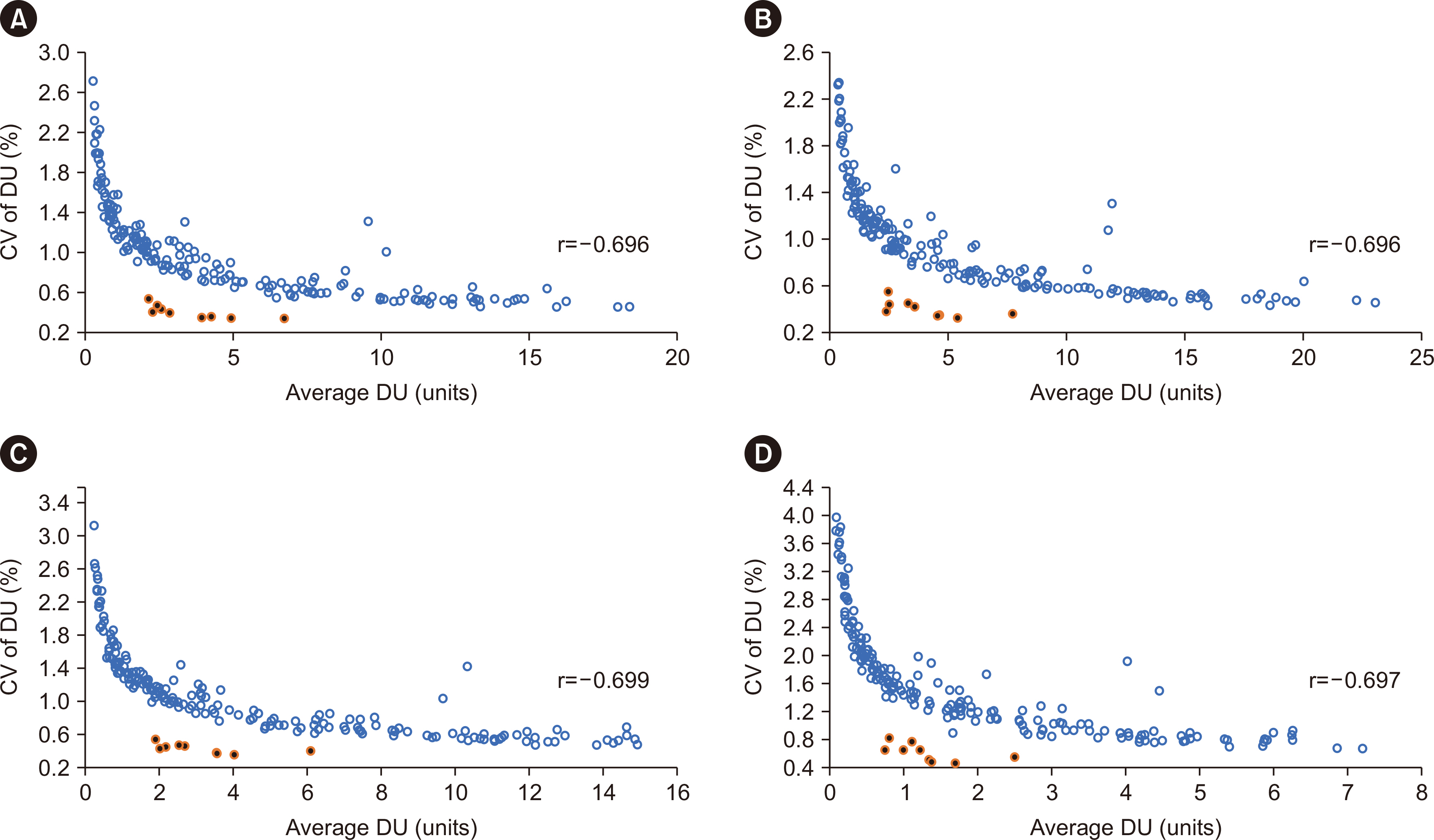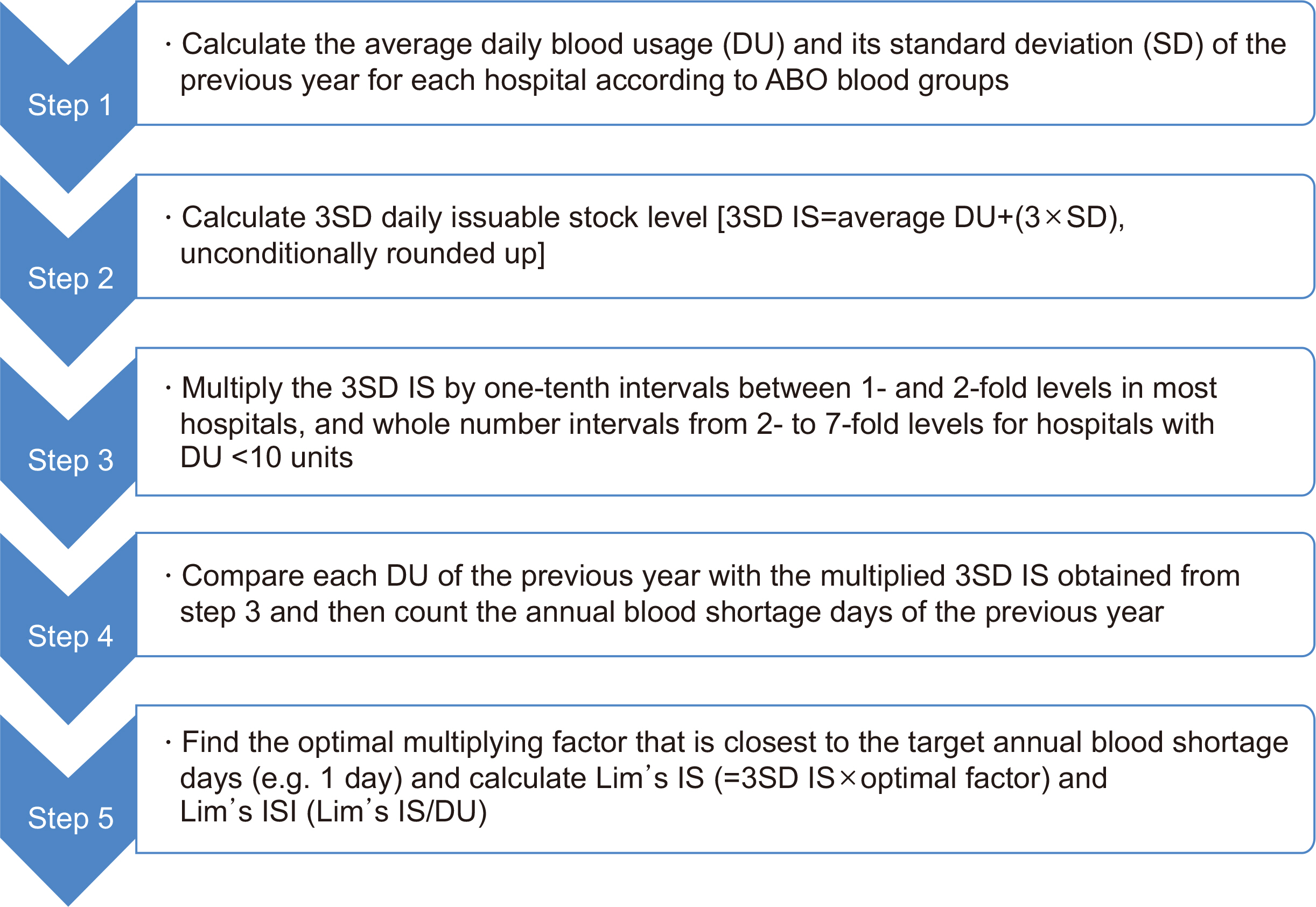Ann Lab Med.
2024 May;44(3):262-270. 10.3343/alm.2023.0242.
Optimizing the Hospital Blood Bank Stock in Korea: A Comparative Analysis of the Uniform 5-Day Stock Index and a Novel Blood Stock Index
- Affiliations
-
- 1Department of Laboratory Medicine, Ajou University School of Medicine, Suwon, Korea
- 2LabGenomics Clinical Laboratories, Seongnam, Korea
- KMID: 2555697
- DOI: http://doi.org/10.3343/alm.2023.0242
Abstract
- Background
Maintaining optimal blood inventory levels in hospitals is important to prevent blood shortage and wastage. We aimed to provide an efficient blood inventory management strategy for hospital blood banks nation-wide by comparing the current use of 5-day issuable stock (IS) with Lim’s IS as a novel target IS.
Methods
The average and CV of daily usage (DU) were calculated from information entered into Korea’s Blood Management System by 194 participating hospitals in 2019 and 2020. Using these data, Lim’s IS was calculated by determining the simulated annual average blood shortage day nearest to 1 for each blood group in each hospital. The 5-day IS (5IS) was estimated by multiplying the average DU in 2018 by five to count the shortage days in 2019.
Results
The average DU (0.3–231.3 units) and corresponding CV (0.33–7.14) in the participating hospitals were inversely proportional (r = –0.699 to –0.695). The hypothetical averages of 5IS and Lim’s IS were 27.0 ± 41.2 and 24.7 ± 20.8, respectively (P = 0.006). The shortage days for 5IS and Lim’s IS were 8.9 ± 22.7 and 1.0 ± 1.9, respectively (P < 0.001).
Conclusions
While 5IS was unacceptable for universal application, Lim’s IS remained near one shortage day and is considered more efficient than 5IS. Hospitals should implement indicators that consider DU and its variations. This is the first study to introduce Lim’s IS as an indicator of optimal blood inventory, and the data are expected to provide guidance for effective blood inventory management nationwide, particularly during blood shortages.
Figure
Reference
-
References
1. National Blood Authority Australia. Managing blood and blood product inventory - Guidelines for Australian health providers. https://www.blood.gov.au/inv-mgt-guideline. Updated on July 2023.2. Oh JA, Shin JY, Lee KY, Jeong KE, Seo CR, Choi YS, et al. 2013; The status of the Korea blood inventory monitoring system, 2009~2012. Korean J Blood Transfus. 24:33–40.3. Chang WR, Lim YA. 2008; The inventory levels of red blood cells from sentinel hospitals in Korea according to the blood type. Korean J Blood Transfus. 19:155–64.4. Chapman JF, Cook R. 2002; The Blood Stocks Management Scheme, a partnership venture between the National Blood Service of England and North Wales and participating hospitals for maximizing blood supply chain management. Vox Sang. 83:239–46. DOI: 10.1046/j.1423-0410.2002.00218.x. PMID: 12366766.5. Park KU, Kwon SY, Kim SW, Lim YA. 2006; Long term prospects for the blood supply and demand. Korean J Blood Transfus. 17:1–10.6. Kim HO. 2022; Current state of blood management services in Korea. Ann Lab Med. 42:306–13. DOI: 10.3343/alm.2022.42.3.306. PMID: 34907100. PMCID: PMC8677471.7. Ministry of Health and Welfare. Manual for blood supply and management in blood shortage crisis. Social Disaster Document-22. https://www.kha.or.kr/board/dept/list?siteGb=HOME&siteCd=HOME&rMnuGb=ASW&brdMstIdx=61&menuIdx=921. Updated on Nov 2023.8. Lim YA, Kim HH, Joung US, Kim CY, Shin YH, Lee SW, et al. 2010; The development of a national surveillance system for monitoring blood use and inventory levels at sentinel hospitals in South Korea. Transfus Med. 20:104–12. DOI: 10.1111/j.1365-3148.2009.00986.x. PMID: 20015060.9. The Korean Society of Blood Transfusion. 2023. Transfusion Medicine. 5th ed. Korea Medical Book Publishing Company;Seoul: p. 284.10. Jeong KE, Oh JA, Kim JN, Lim YA. 2020; Research for improvement of the Korean blood supply and demand monitoring. Public Health Weekly Report. 13:1717–27.11. National Health Service Blood and Transplant United Kingdom. Annual reports: information about the blood supply chain in England, Wales and Northern Ireland. https://www.bloodstocks.co.uk/resources/annual-reports/. Updated on July 2023.12. Devine DV, Sher GD, Reesink HW, Panzer S, Hetzel PA, Wong JK, et al. 2010; Inventory management. Vox Sang. 98:e295–363. DOI: 10.1111/j.1423-0410.2009.01252.x. PMID: 20432515.13. Sun X, Xu Z, Feng Y, Yang Q, Xie Y, Wang D, et al. 2021; RBC inventory-management system based on XGBoost model. Indian J Hematol Blood Transfus. 37:126–33. DOI: 10.1007/s12288-020-01333-5. PMID: 33707845. PMCID: PMC7900290.14. Shih H, Rajendran S. 2020; Stochastic inventory model for minimizing blood shortage and outdating in a blood supply chain under supply and demand uncertainty. J Healthc Eng. 2020:8881751. DOI: 10.1155/2020/8881751. PMID: 32952991. PMCID: PMC7481960.15. King PL. Understanding safety stock and mastering its equations. APICS magazine. https://web.mit.edu/2.810/www/files/readings/King_SafetyStock.pdf. Updated on Aug 2011.
- Full Text Links
- Actions
-
Cited
- CITED
-
- Close
- Share
- Similar articles
-
- A comparative study on the accuracy of impression body according to the types of impression tray
- The Experience of Applying an Australian Red Blood Cell Safety Stock Calculation to Korean Hospitals
- Accuracy of stone cast produced by adjustable dental impression tray
- A comparative study of impression methods using stock tray and intraoral scanner in a completely edentulous
- Alloplastic total temporomandibular joint replacement using stock prosthesis: a one-year follow-up report of two cases



